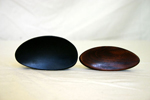
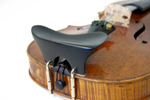
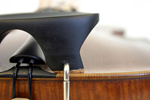
Size of Cup
In the final custom made chin rests the size of the cup tended to be smaller than most store bought models. Store bought chin rests are built roomy to allow for different players to use the rest in different ways. The usual result is that the individual player gets less grip on the chin rest because the shape does not match his/her particular jaw shape. The player has to make extra effort to secure the instrument by tensing or twisting the neck, jaw and shoulder muscles to clamp the instrument in place.
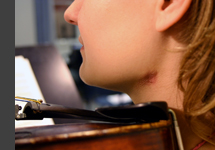
Neck sores disappear
Neck sores, common in violin and viola players, are often made worse by an ill-fitting chin rest rubbing and pressing on the throat. The sores began to disappear spontaneously on most players when the chin rests fit better. We took care that pressure on the oesophagus (wind pipe) and arteries of the neck was also eliminated.
* A neck sore shows where an ill-fitting chin rest has been rubbing.
Shifting easier
Willemijn’s narrow jaw shape meant that a larger chin rest, like the Flesch model, tended to press into her throat. Her custom made chin rest has a narrower cup than the testing kit model, to fit the shape of her jaw. This also gives her a better grip on the instrument when she needs to shift down.
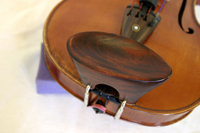
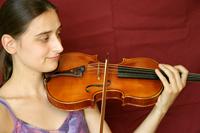
1.* Willemijn’s custom made chin rest
2. Willemijn June ’05
Contour of Cup
We matched the contour the chin rest cup to the contour of the jaw, giving it just enough edge to be able to hook it just under the jaw bone without pressing on softer throat structures.
Improved grip gives more sound
Daniel’s final custom chin rest is a good example of a contoured chin rest cup. The contour of cup respected the curves in Daniel’s jaw and the pointed shape of his chin. He reported that his sound improved because the fit of the chin rest and the increased height helped him to keep the neck of the violin from drooping, increasing the contact of the bow on the string.
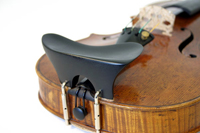
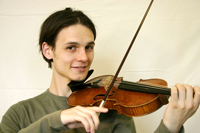
1. Daniel with his custom made chin rest.
2. Daniel’s custom made chin rest
A better fit eliminates pain
Monica’s original chin rest cup was too deep on one side for her square jaw, which meant that she had had to jerk her head to the left to get a grip on the instrument. This gave her considerable pain after playing.
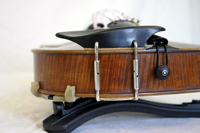
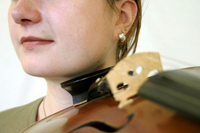
1. Monica’s old chin rest dipped down to the left, giving little grip.
2. Monica’s custom made chin rest matched her square jaw shape.
The cup of her final custom chin rest was narrower and shallower than her original chin rest, so that she no longer has to hunt for contact between jaw and instrument. Monica reported that these changes in her chin rest eliminated long-term pain in her neck; her persistent headaches after playing also disappeared.
Position of Cup
In the final custom chin rests, the position of the cup could be matched to the position of the jaw of the player. The adjustments to the position of the cup discussed here are: right and left of centre, towards and away from the edge of the instrument.
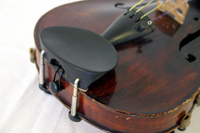
The taller a player is, the more to the left of centre the chin rest has to be, and the further away from the edge of the instrument. This last adjustment allows the instrument to nestle near the throat, without the chin rest pulling it away from the player. (see below: Extra adjustment for taller players)
A centred chin rest cup
Minor variations from the centred position of chin rest served to meet the needs of all the players, from shortest to tallest. A chin rest with the cup positioned entirely to the left of the tailpiece turned out not to be useful to the players as it put the instrument into a position that was awkward for the arms and hands.
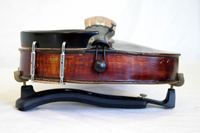
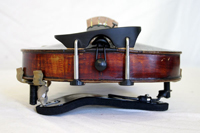
1. To the left: a chin rest with cup positioned to the left of the tailpiece Iren. Nov. ’03
2. Over the middle: A chin rest with the cup positioned over the tailpiece Iren. June ’05
Variations on the centred chin rest cup
The position of the chin rest cup depended on the height of the player, and the length of the arms. For small players the chin rest cup was centred directly over the tailpiece, allowing the fingerboard to be held more towards the centre. This made all strings accessible to the shorter bow arm. For tall and some middle-sized players we positioned the cup of the chin rest slightly to the left of centre, allowing the fingerboard to be held more towards the left. This gave them more room for their longer arms to bow at the frog. These variations in the centred position of the chin rest never brought the cup all the way over to the left of the tailpiece, as is found in some models.
>>Adjusting the violin position




1. Over the middle Noelia, Nov. ’03
2. Slightly to the left Monica (viola), June ’05
3. More to the left Huug, June ’05
4. Attached left, reaching back over the middle. Mikel, June’05
Viola players also need more room to bow
The violists in our research also needed the cup of the chin rest to be positioned slightly to the left of centre. This seemed to be because the space needed for bowing is greater due to the size of the instrument.
For one violist, Klaartje, we adapted a Flesch chin rest to change the height, position and the tilt. To alter the position of the cup in her final custom made chin rest, we re-formed the wooden feet of the chin rest to allow more space between them. Then we could move it to the left towards the C string. Klaartje reported that this gave her more room to bow at the frog, which freed up her right shoulder when bowing.
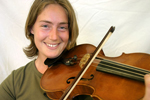
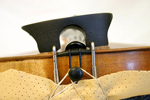
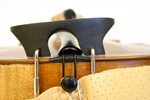
1. Klaartje (viola) June ’05
2. Klaartje’s chin rest from the Testing Kit, before position was adjusted. Middle of research, Jan. ’04
3. Klaartje’s final chin rest, adjusted to left to give more bowing room. End of research June ’05
Extra adjustment for taller players
The position of the cup was sometimes set further in away from the edge of the instrument, or rotated slightly to insure that the edge of the cup did not press on the wind pipe (oesophagus) or the arteries in the throat. This is especially important for tall players: as the chin rest is raised in height, the top edge needs to be placed further away from the throat. This also allows the instrument itself to nestle comfortably on the collar bone near the throat, without being pulled away from the player by the edge of the chin rest higher up.
Mikkel is tall (1.83 meters, with a neck length of 13 cm*) and he also has a narrow chin shape. Because of this, the cup of his custom made chin rest is a little narrower than the Flesch model and it is rotated inwards quite a lot on the e-string end to contact his jaw better. This means that the side of the chin rest (near his throat) slants in slightly towards the bridge. This brings the edge of the chin rest into position right under his jaw bone, giving him the grip he needs to secure the violin with his jaw.
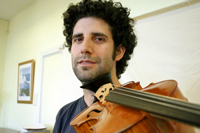
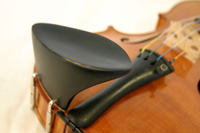
Chin rest for a tall player: the cup position is matched to the jaw position. Mikkel’s final custom madechin rest, June ’05
